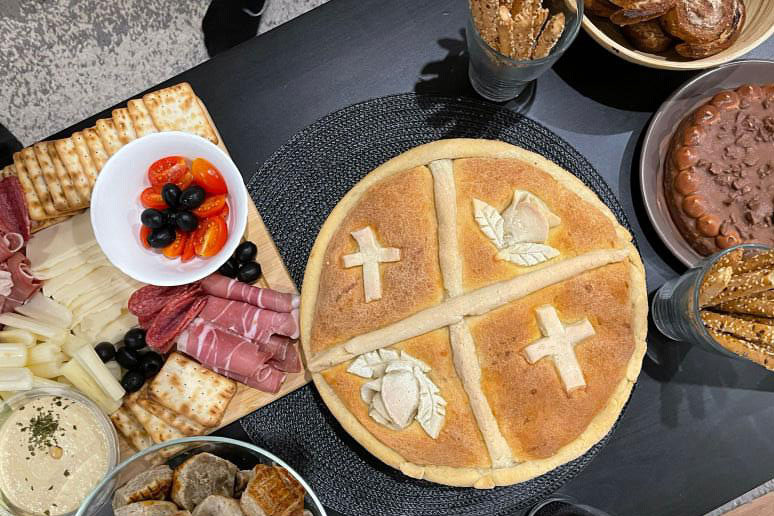Among Orthodox Christians in the former Yugoslavia, one of the main holiday foods is a round Christmas bread called česnica (pronounced chess-NEE-tsa). Many Orthodox Christian traditions that have survived to this day have roots in Slavic paganism, and česnica is no exception.
In religious terms, the bread’s main purpose is to represent the body of Christ at Christmas. But older traditions relate to the bread’s ability to tell fortunes and to predict good luck and prosperity, based on finding a small object hidden in the bread. In many regions, the hidden object is a coin; in others, it may be a kernel of wheat, a shelled walnut, a figurine, or even a bone from a small animal.
After the bread is baked, the whole family comes to the dinner table to spin the bread between them. When it has stopped spinning, everyone uses their right hand to tear out a piece of the česnica. Whoever finds the coin in their part of bread will have good luck with money for the coming year. If nobody finds the coin right away, then the family of the host will enjoy the good luck.
Serbain writer and linguist Vuk Karadžić (1787–1864) noted these traditions in the early nineteenth century. In one of his dictionaries, Karadžić describes the ritual spinning of the česnica between two men. When one asks, “Can you see me?” the other replies, “I can see you a little.” Then the first man concludes, “You can see me now a little, but by next year you won’t see me at all”—meaning that next year’s harvest will be so bountiful that the česnica will be too big to see someone across it. This traditional exchange invokes good luck for the coming year’s harvest.
Because most Orthodox Christians follow the Julian calendar, they observe Christmas on January 7 and bake česnica on Christmas Eve. According to tradition, there are several necessary steps:

- Bathe or shower before starting to cook. The person who bakes the bread must be clean and should not have anything on their heads, such as a hat, shawl, or scarf.
- Take the flour from a new, full bag.
- Take the water for the bread from three different springs, and do not use this water for anything else.
- After kneading the dough, touch all the fruit trees to secure their harvest, and touch all the livestock ensure their good health.
- Bake the česnica in the main oven below a bouquet made from the branches of an oak tree, or badnjak. The oak tree symbolizes life in many traditional Slavic cultures.
- Use only your hands and not any utensils when handling the česnica.
Serbian Česnica
Ingredients
2 pounds wheat flour
2 cups milk
1 cube yeast
1 egg
A bit of salt
Preparation
Melt the yeast cube in a small amount of warm milk. Add one whisked egg and a bit of salt, and then mix while periodically adding the flour and the rest of the milk until the dough is smooth.
Knead the dough well, then cover with a clean cloth and let rise. When it starts to rise, resume kneading. The dough shouldn’t rise entirely.
Shape the dough into a round loaf, roughly 12 inches (30 cm) in diameter and 5 inches (12 cm) in height. Insert a clean coin somewhere in the česnica.
Bake the česnica in an oiled pan for 10 minutes at 400 degrees Fahrenheit, then lower the temperature to 300 and bake until done. It should look crisp, and a knife stuck into the bread should emerge dry.
Decorate the top of the česnica with agricultural or religious motifs—typically small decorations made from thicker dough (just flour and water). In some regions, they make the česnica sweeter by spreading honey on top.

Nadja Gavran is an intern at the Center for Folklife and Cultural Heritage and student at the University of Pécs in Hungary, studying musical creative arts and musicology. She is originally from Belgrade, Serbia.


